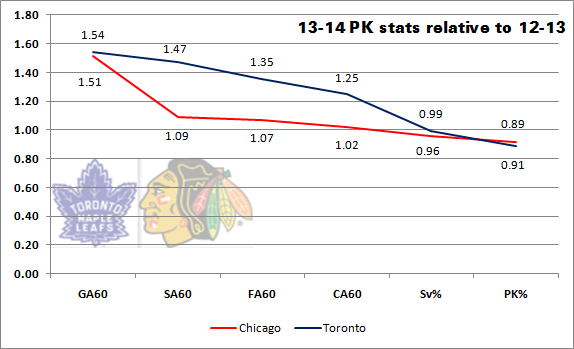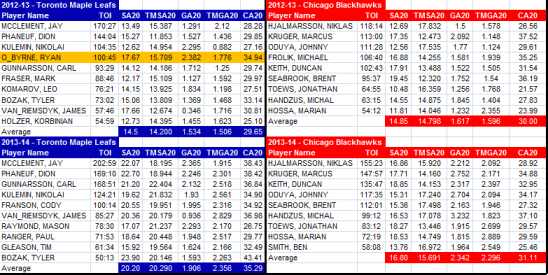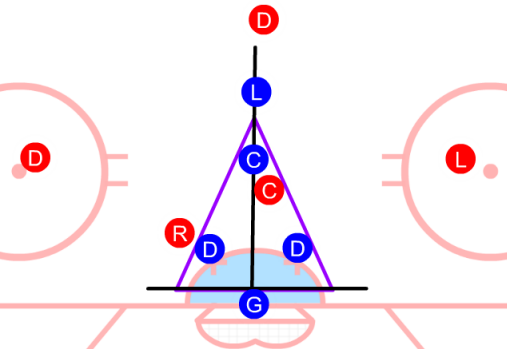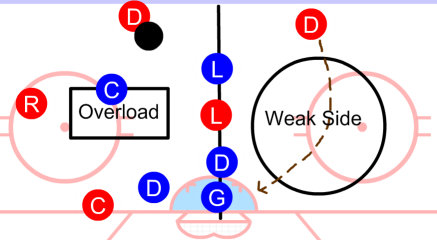This is wrong. I should know, I wrote it.
A systematic explanation of the Leafs penalty killing isn’t fully available to explain the dramatic drop off. There isn’t enough of a systematic change from what made the units successful in ’12-13.
The unchanged system WAS the explanation, as we shall see explained below. The phrase irked me from the moment of publish. It felt incomplete, anticlimactic. There had to be more and there was.
The quote was taken from a block of posts on Maple Leafs systems for Maple Leafs Hot Stove, focusing on the defensive zone coverage, offensive and neutral zone forecheck and the final installment focusing on the Leafs penalty killing system.
While I did my best to identify the system, the consequences of utilization weren’t evident enough to provide insight for the woeful penalty kill in 2013-14 that proved successful in the shortened 2012-13. Identifying system utilization is only partial analysis in the absence of the counter, the system designed to counteract the intended result.
Methodology aside, analysts must adapt based on changing data or circumstances, a sentiment illuminated through the analytics community, but based on a universal truth. Better information, better judgement.
Shortly after the series was done, personal curiosity induced a non-scientific viewing of other NHL special teams, in a conceptually grandiose effort to decipher NHL special teams philosophy. Ideally documenting special team philosophy universally would go a long way in enhancing overall analysis however, pitfalls arise on the deterministic nature of systems implementation and decisions.
I feel systems implementation is almost exclusively coaching. Changes behind the bench (whether head or associate coaches) will alter systems and effectively diverts attention from that of organizational philosophy to that of a coaching staff. Team’s may dictate and trickle down philosophy via upper management, but the battle formations are generally influenced by designing a system to use with the available team players (assets) by coaching staff.
I digress.
The purpose of this post is to theorize on the decline of the Leafs vaunted penalty kill from the top of the NHL in the lockout shortened 2012-13 to the bottom of the standings in 2013-14.
Toronto shares a remarkable parallel with the defending Stanley Cup Champions Chicago Blackhawks, having experienced a dramatic drop in penalty kill efficiency from ’12-13 to ’13-14.
The commonality doesn’t end there. Both teams are ostensibly exclusive to the NHL in that they share the same penalty kill system. No other teams utilize the Czech Press (also referred to as wedge +1 in some circles) as the primary penalty killing system.
Let’s look at the data.
From the table, the most glaring jump is the increase from goals against per 60 minutes. Note the disparity between the lockout shortened season ending at 48 games, while until the Olympic break, both clubs have played 60 games and an increased amount of minutes.
When comparing the results in 2013-14 relative to 2012-13 and graphing it, the chart looks like this. Goals against per 60 minutes year over year are up over 50% for both clubs , while both have experienced a drop in save percentage and PK efficiency.
Strange how the divergence would suggest this is primarily an issue of goaltending, with the Leafs showing a dramatic bump in shots against per 60 with Fenwick and Corsi events following suit and the Blackhawks with a slight bump in all shot-based events and a drop in penalty killing efficiency.
 Data at the player level is also revealing, with values bumped up across the board for penalty killers from last season to this season. The Leafs amplified values on average coincide with the team level and greater than the inflationary effect for the Blackhawks except for GA/20 where the 2012-13 value of 1.62 balloons to 2.34 while Toronto has allowed almost half a goal more year over year at the player level.
Data at the player level is also revealing, with values bumped up across the board for penalty killers from last season to this season. The Leafs amplified values on average coincide with the team level and greater than the inflationary effect for the Blackhawks except for GA/20 where the 2012-13 value of 1.62 balloons to 2.34 while Toronto has allowed almost half a goal more year over year at the player level.
A little further down this post will be a reference of the effects of losing penalty killer Michael Frolik, yet captain Jonathan Toews and veteran Marian Hossa values have also bumped. Simply put, losing Frolik is irrelevant to the discussion.
What changed?
The NHL changed.
And in my theory, I believe that is the core of the problem.
1-3-1 Power Play Goes Universal
Late last season, the Leafs made a couple of notable changes to their power play formation. Similar to the majority of the NHL, primarily defaulting to an overload formation I noticed they switched to a default of 1-3-1. The Leafs weren’t the only team to adopt this pattern.
Across the NHL, there was a universal change to the 1-3-1 as the default power play setup. Teams would enter the zone and set up the play using an overload of forwards until completing the setup and then dropping a point man down to the middle and positioning the lone point man at the top, a skater at the goal (and opting to the side to facilitate a make-shift triangle with the slot man) and three players across the middle.
Up until this season, most teams defaulted to the overload with two defensemen at the top of the zone, and forwards forming a triangle on either side of the lower part of the zone, essentially overloading one side and leaving space on a weak side – offering a back door play (illustrated and expanded on below).
Most teams use a box formation (with some using a diamond with similar logic). The box expands and contracts according to puck situation in the defensive zone, while moving laterally for pucks positioned far along the boards, or collapsing should the puck get in deep under the goal line.
This short video describes provides a visual:
In zone defensive coverage the Maple Leafs use is a system called the Czech Press. I won’t get into the many details since I’ve already detailed it in the MLHS post (that provides lots of in-game video outlining this approach as well).
I’ll repost this one video that shows the Czech Press and the fronting technique. Pay attention to just how easy it is to get a lane open to get a shot on goal and the chasing forward at the high end of the zone. James Van Riemsdyk in particular chases the puck carrier as the slot man stays put, which is part of system design and proved quite effective last season.
This video shows the concept from the theory.
Chicago just like the Maple Leafs have been using the exact same system both seasons. This excerpt comes from an NHL.com December article outlining the penalty killing issues for Chicago provides confirmation of that. The visuals indicate as much.
There was a bit of hesitancy in his voice at the time, because the trend in killing penalties has been mostly negative this season. After finishing third in the NHL in the regular season and 2013 Stanley Cup Playoffs, it's definitely odd to see the Blackhawks at the bottom of that stat category.
They did lose a great penalty killer, fourth-liner Michael Frolik, who was traded to the Winnipeg Jets, but one player couldn't make that much difference. The question, then, is, what's the biggest problem?
"We've [had] pretty much the same system as last year and [we're] going back and forth [looking at] what we did, but we need to execute better," said center Marcus Kruger, who along with Frolik got a lot of credit for last season's penalty-killing success. "It's up to us here in the locker room to do a better job."
I agree that losing Frolik isn't as detrimental to the overall penalty kill. One player doesn’t disintegrate the penalty kill as much, and if it did, it doesn’t explain the Leafs issues considering they didn’t really lose anyone like the Blackhawks, save for Leo Komarov.
The points to pay attention to is the man in the slot and how the penalty killers alternate to ensure there’s a man occupying the slot at all times. The other point is to watch for the man fronting at the top of the zone when the puck is positioned there. Picture an inverse ‘T’ as shown in the image below. The triangle constitutes two defensemen at the bottom and the slot man at the top, with another player ‘fronting’ or positioned in front of the slot man.
The ‘L’ player in the image positioned ahead of the ‘C’ (arbitrary values for the sake of descriptive differentiation, not literal positions of Left winger or Center) is the designated chaser. His job is to flush out the puck carrier to force a pass, hurry up a play he doesn’t want to really make, or ideally create a turnover in favor of the penalty killers, or clearing the zone. The player in the lower part of the stack is entrusted with recovering the puck on the event of a turnover, while the flusher then occupies the slot as a replacement.
Here are the Blackhawks examples. This first one features Andrew Shaw and Marcus Kruger as the two forwards. Kruger has been extolled as a defensive stalwart, but this particular example shows some awkward coordination as a penalty killer. Shaw displayed some intuitive struggles as well, but I do believe that they are fine defensive players.
This subsequent video features Jonathan Toews and Marian Hossa as a penalty killing tandem along with others like Shaw, Brandon Saad, Ben Smith (who even directs his partner to be the lead man engaging the puck carrier at the top of the zone), Michal Handzus and even Brandon Bollig. Note that Bollig didn’t appear in the list of players outlined in the table above since he’s played less than 50 minutes 4v5, but make the point that he has seen time as a penalty killer. It’s not solely about the personnel, it’s about the system and success determined by playing within the structure of that system.
The main point here is just how easy it is for the opposition using a 1-3-1 to generate a shot on goal opposed to a box formation that will take some space away from cross-seam passes to wingers along the boards with active sticks and simple presence.
Just like the point I made earlier in the post, I’m hesitant to believe that the loss of Michael Frolik merits any explanation to base the Blackhawks decline in penalty kill efficiency. A system should be greater than any individual part, although it’s clear that some players exhibit attributable defensive skills intuitively that assist in contributing to PK success. That may stem from neutral zone forecheck or the ability to guide teams into lanes that create turnovers prior to zone entry. After that, it’s all about positioning, intuition and simply put, work.
Frolik could be the ‘C’ or ‘L’ in the system above and the Blackhawks penalty kill could still have faltered this season.
Czech Press Vs. Overload Vs. 1-3-1
So what’s the problem here? Why the dramatic drop in penalty kill efficiency? Remember when I stated that the NHL changed, but the Leafs and Blackhawks penalty kill did not? That’s the problem.
Until this season, most NHL teams defaulted to an overload power play. This pattern has two players at the point (usually two defensemen) with the forwards forming a triangle on one side of the ice, intrinsically overloading the one side of the ice and creating a weak side.
The weak side created opportunities for back door plays with the focus is on the overload side of the ice, affording the weak side point man to slip down through coverage unattended for a tap in courtesy of a cross seam pass, or exerting net pressure in the case of rebounds from shot attempts.
That was until 2013-14 where most teams adopted the sexiness of the 1-3-1 as the default power play. This is where the bottom falls out.
With two point men, it’s easier to utilize the rocking motion of the forwards along the slot to limit shots, take away space and block passing lanes with active sticks and quick feet. I feel that it’s more difficult to do this with a single point man and the spread across the middle making the 1-3-1 more difficult to defend against using a Czech Press.
In this last video, I’ve demonstrated how the Leafs/Hawks system played out against the overload to contrast all the other video evidence against the 1-3-1.
Presenting all of this is not a definitive analysis, but there’s a fairly solid case cited through commonalities exclusively attributed to these two teams, somewhat explaining the results year over year.
I’ve made an effort to look at all NHL teams to identify their systems. Most teams use some kind of box formation – as I stated above – and now teams are mostly defaulting to the 1-3-1 as a power play formation. I haven’t looked to see just how the box (or other formations) match up to the three men across the middle. That would be an extensive undertaking and would change with a firing of a coach and out of the scope of this exercise at this point in time. If there are other teams that do in fact use the Czech Press or don’t default to the 1-3-1 (Phoenix sometimes comes to mind here) I would be open to reviewing that and of course assimilating this new information to include in the future.
There is another issue.
Even if both clubs have identified the problem, what could possibly be done now at this point in the season after 60 games played. While the Blackhawks can afford to lose a few points should they try to assemble an upgraded penalty killing strategy, the same can’t be said of the Maple Leafs who are already battling for a playoff spot, while playing a game where they are consistently outshot, or outplayed based on every possible metric.
Identifying and addressing the problem is not likely to occur in season due to the potential confusion of making changes so close to the playoffs. That’s a task for the off season.
Data provided by hockeyanalysis.com
System animation created through sportsdood.com app (hockeydood)
**********
Follow the McKeen's team on Twitter:



































